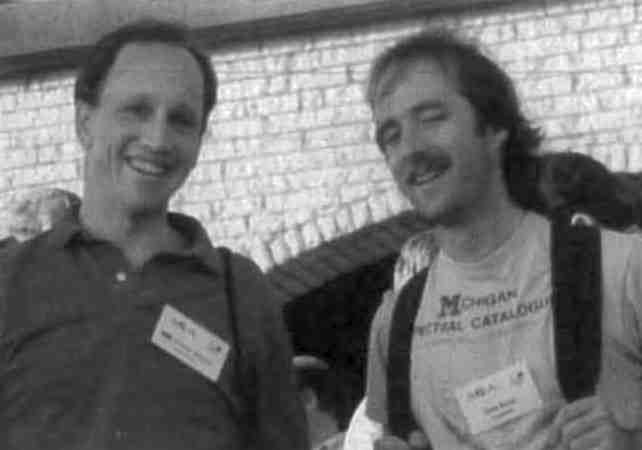


Awards and prizes
Awards to Crystallographers
Aminoff Prize
The Royal Swedish Academy of Sciences has awarded the Gregori Aminoff prize in crystallography for 1996 to Philip Coppens, Buffalo, USA, in recognition of his outstanding methodological and structure-chemical achievements in crystallography, especially the studies of electron distribution in different types of chemical bonds. The prize was received from the hands of His Majesty The King, Carl XVI Gustaf, at the Academy's Annual Meeting on March 26, 1996.
To honor Philip Coppens a symposium was organized at the Academy on March 25 with the title "Electron Density and Chemical Bonding." About 60 scientists from the Nordic countries participated in the meeting. Coppens gave a lecture on "The relation between X-ray charge densities and other physical techniques, such as resonance scattering, Mössbauer spectroscopy and photoelectron spectroscopy. Trends in charge densities of related substances and future possibilities." The following lectures were also delivered: B. Forsyth (ISIS, Rutherford Appleton Lab): "Neutrons in pursuit of the chemical bond", P. Becker (Ecole Centrale Paris): "Predictive applications of electron distributions in real and momentum space", C. Gatti (CNR-CSRSRC, Milano): "The electron density topology and the characterization of atomic interactions in molecules and crystals", K. Hermansson (Uppsala): "On the relation between vibrational frequency shifts and electron density shifts", M. Spackman (Armidale, Australia): "Making use of experimental charge densities".
Ivar OlovssonChairman, Swedish National Committee of Crystallography
Surface Structure Prize
J. B. Pendry has been awarded the first Surface Structure Prize. This new Prize will be sponsored once every three years by the International Conference on the Structure of Surfaces (ICSOS). The first award recognizes Pendry's far-reaching, diverse, fundamental, and practical contributions to the field of quantitative surface structure determination. He has, in particular, introduced a series of powerful theoretical and computational methods which have been widely adopted to interpret data measured with a variety of techniques sensitive to surface structure.
Thanks largely to Pendry's innovations, low-energy electron diffraction (LEED) has emerged as the most effective and productive technique for surface crystallography; it has contributed over 60% of the detailed surface structures described to date. Pendry introduced critical methods that are in wide use within LEED computer codes today.
In recent years, Pendry's "Tensor LEED" has enabled the solution of far more complex surface structures than before. He has made many pioneering contributions to the techniques of EXAFS, SEXAFS, XANES, HREELS, photoelectron diffraction and inverse photoemission. With his collaborators, he has produced, and made available worldwide, computer programs in all these fields.
Pendry's 1973 book, Low Energy Electron Diffraction: The Theory and Its Application to Determination of Surface Structure, was a major watershed in surface science. It still serves as the basic source for LEED theory, thanks to its foresight and completeness.
M. A. Van Hove, ICSOS ChairmanArt of Dyeing Prize
We are pleased to report that the annual Research Medal of the Worshipful Company of Dyers for 1995 was awarded to Alan Whitaker, formerly of the Department of Physics, Brunel (UK) for the series of papers on the "Crystal Structure of Organic Pigments" published in the Journal of the Society of Dyers and Colourists over a period of years.
The gold medal is inscribed "for research work in connection with the art of dyeing." Although the medal was awarded by the Worshipful Company of Dyers, the selection was made by a joint committee of the Company and the Society of Dyers and Colourists.
Editor's Note: The rumors that Dr Kavorkian had been a contender for the prize seems to be unfounded.
Lewis-Jeantet Prize
Nigel Unwin of the Medical Research Council Laboratory of Molecular Biology (UK) shares the 1996 Lewis-Jeanter Prize for Medicine awarded in Geneva in April 1996. Unwin and Richard Henderson were pioneers in the area of electron diffraction and were the first to determine the three-dimensional structure of an integral membrane protein, rhodopsin.
 Pfizer Prizer Karplus and an unidentifed crystallographer up against the wall at the the 1992 ACA Meeting in Pittsburgh. Photo W.L.D.
Pfizer Prizer Karplus and an unidentifed crystallographer up against the wall at the the 1992 ACA Meeting in Pittsburgh. Photo W.L.D.
Pfizer Award
The Biological Chemistry Division of the ACS has chosen P. Andrew Karplus as the recipient of the 1996 Pfizer Award in Enzyme Chemistry. Karplus, professor of biochemistry at Cornell University, recently solved the structure of urease - the first enzyme ever to have been crystallized and thus shown to be structurally homogeneous.


